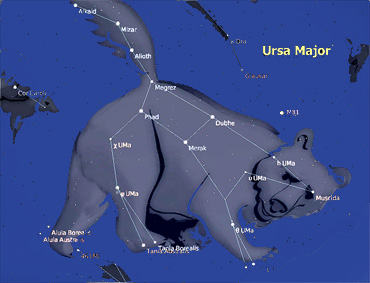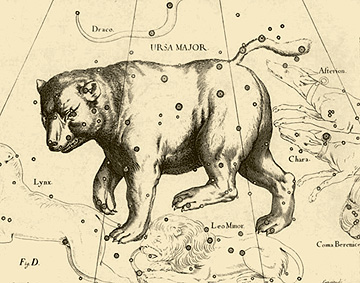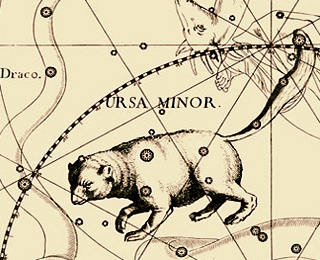

Home Toy Bears Nature Bears Mythical Bears Historical Bears Bear Friends Resources

URSA MAJOR & URSA MINOR
Bear Myths in the Sky
 They are the bears you can see every night. All you need do is look
up. At least with no clouds. In ancient times, men would look up to the
stars twinkling in the heavens and see in them the patterns which represented
the creatures and characters of legends and the Gods. Ursa
Major, Latin for the large bear or the Great Bear is better known as
the Big Dipper
- in
England as the Plough (plow but the English spell
funny). Two of the stars of the big dippers bowl point to the North Star “Polaris” which
was a key fix for ancient mariners. The north star stays stationary in
the sky because it is above the Earth axis, so as the world spins, the
other constellations move through the night, but the North Star stays
steady. Polaris is the star at the end of the tail of Ursa Miner – the
Little Bear. It was not only the Europeans who saw these stars as bears,
but were the same in many cultures.
They are the bears you can see every night. All you need do is look
up. At least with no clouds. In ancient times, men would look up to the
stars twinkling in the heavens and see in them the patterns which represented
the creatures and characters of legends and the Gods. Ursa
Major, Latin for the large bear or the Great Bear is better known as
the Big Dipper
- in
England as the Plough (plow but the English spell
funny). Two of the stars of the big dippers bowl point to the North Star “Polaris” which
was a key fix for ancient mariners. The north star stays stationary in
the sky because it is above the Earth axis, so as the world spins, the
other constellations move through the night, but the North Star stays
steady. Polaris is the star at the end of the tail of Ursa Miner – the
Little Bear. It was not only the Europeans who saw these stars as bears,
but were the same in many cultures.
The Myth of the Great Bear - Ursa Major
 In
the mythoolgy stories of the Greeks, Zeus lusts after a young maiden
named Callisto, the daughter of cruel King Lycaon of Arcadia who ran
away to be with the wood nymphs of Zeus' daughter Artemis, the huntress.
Callisto bore the king of the gods a child, and Zeus' wife Hera,
so jealous of Callisto's beauty and her husband's infidelty,
cast a spell, turning Callisto into a bear.
Her son was named Arcus, meaning child of the bear. When Arcus grew
older, while hunting in the woods one day, he came a bear. It was his
mother, but he diidn't know it.
He was about to shoot her with his bow, but Zeus sees them and to avert
the tragic end flings them both into the sky, forming the constellation
of the Great Bear, forever turning in the sky as a hunted animal. He
gave Callisto such a great prominence in the sky, always to be on view,
to annoy his wife. It was that kind of marriage. Zeus gave the great
bear a little bear so she could have a son, with Arcus chasing them
with his bow. Which is curiously very similar to how the Iroquois Indians
of North America saw the three
brightest
stars as
three hunters chasing a bear through the night sky with the lead hunter
carrying a bow and arrow
In
the mythoolgy stories of the Greeks, Zeus lusts after a young maiden
named Callisto, the daughter of cruel King Lycaon of Arcadia who ran
away to be with the wood nymphs of Zeus' daughter Artemis, the huntress.
Callisto bore the king of the gods a child, and Zeus' wife Hera,
so jealous of Callisto's beauty and her husband's infidelty,
cast a spell, turning Callisto into a bear.
Her son was named Arcus, meaning child of the bear. When Arcus grew
older, while hunting in the woods one day, he came a bear. It was his
mother, but he diidn't know it.
He was about to shoot her with his bow, but Zeus sees them and to avert
the tragic end flings them both into the sky, forming the constellation
of the Great Bear, forever turning in the sky as a hunted animal. He
gave Callisto such a great prominence in the sky, always to be on view,
to annoy his wife. It was that kind of marriage. Zeus gave the great
bear a little bear so she could have a son, with Arcus chasing them
with his bow. Which is curiously very similar to how the Iroquois Indians
of North America saw the three
brightest
stars as
three hunters chasing a bear through the night sky with the lead hunter
carrying a bow and arrow
The Little Bear - Ursa Minor
 The
constellation with the North Star, also knwn as the Little Dipper and
always paired with the bigger version is seen as a baby bear with
a long tail. The tail is unusually long for a bear as a result of being
swung around in the sky. The smaller bear gets paired with the the Ursa
Major in variations of the Arcus and Callisto legend, that perhaps
Arcus was chasing both bears, but mostly because they can always be seen
together with one following the other. Parts of Ursa Minor disappear
below the
horizon as the Earth turns, but Ursa Major is always on view.
The
constellation with the North Star, also knwn as the Little Dipper and
always paired with the bigger version is seen as a baby bear with
a long tail. The tail is unusually long for a bear as a result of being
swung around in the sky. The smaller bear gets paired with the the Ursa
Major in variations of the Arcus and Callisto legend, that perhaps
Arcus was chasing both bears, but mostly because they can always be seen
together with one following the other. Parts of Ursa Minor disappear
below the
horizon as the Earth turns, but Ursa Major is always on view.
The myths originated in Greek mythology but the names are Latin because the Romans took on the Greek gods and renamed them. The Polish astronomer Johannes Hevelius, also the mayor of Danzig (Gdansk) and a beer brewer in the 1600s was the first of the "modern" era of the science of astronomy to map and illustrate the moon and constellations. He was called the "founder of lunar topography" for his map of the visible surface of the moon. He has a crater named for him, but apprently didn't see any bears on the moon through his telescope.
©2010 WLEV BearBuddys.com